Rising Tides: Watermen rebound from crab disaster
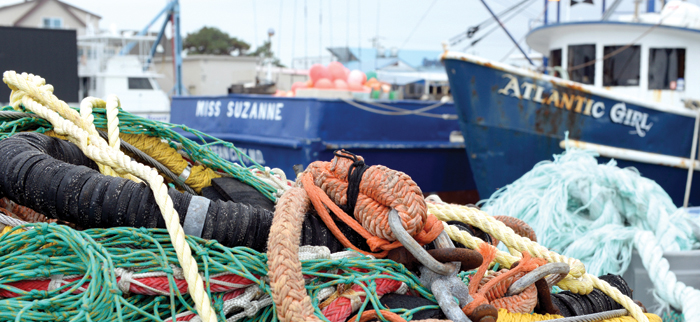
Workboats
In 2008, a deadly combination of pollution, habitat loss, lack of prey and overabundance of predators depleted the Chesapeake Bay’s blue crab population. The U.S. Department of Commerce declared the fishery a state of disaster.
Maryland watermen were down on their luck and the economy was hit hard, prompting the state to request $30 million in grant funding from the National Ocean and Atmospheric Administration (NOAA) National Marine Fisheries Service.
With the goal of providing economic relief to crabbers and preventing future fishery disasters, NOAA granted funding to the Maryland Department of Natural Resources.
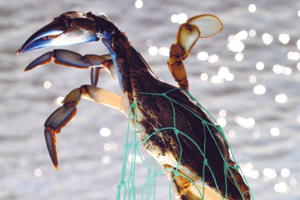
Crab in net; by Ray Jubela
Effects hit home
Crabbers and other watermen were forced to find new work. Many started leading heritage tours to earn a living. Captain Russell Dize, a sixth generation waterman, proved his resilience and resourcefulness by starting one such business, Let’s Go Crabbing.
“When I retired—I’d been in the seafood business, crabbing for 35 years—I wanted something to do,” he says.
For $450, Dize takes a party of six on a four-hour crabbing expedition, allowing the people to keep their haul. If no crabs are caught, Dize promises them a bushel.
“I thought I’d start doing a crabbing charter and show people how to do it,” he says. “You meet a lot of good people doing this.”
The Riley Kat—named for Dize’s granddaughter—sets sail twice a day, seven days a week to go trotline crabbing.
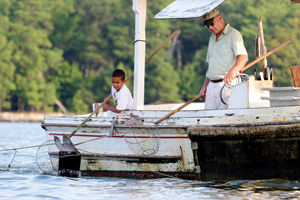
Trot lining for crabs; department photo
Building something new
Captain Mike Vlahovich, or just “Mike V” as some call him, founded the Coastal Heritage Alliance (CHA), an organization that played a prominent role in training watermen to lead heritage tours.
Part of the Waterman’s Heritage Tourism Training Program, CHA joined the Chesapeake Conservancy, the Maryland Waterman’s Association and the Chesapeake Bay Maritime Museum to train more than 100 watermen.
Preserving the culture is crucial to Vlahovich, who grew up fishing salmon in Alaska’s Puget Sound. “I was a salmon fisherman, and that was my heritage,” he explains. “That’s why I was concerned about watermen heritage, because I saw my own vanish. I want to use my experience and my passion to help these communities preserve their way of life.”
Vlahovich believes that educating others about the value of watermen is key to preserving their culture.
“Somehow I wanted to create a venue where I could teach the public about the working waterfront fishing culture, because people aren’t really exposed to it,” he says. “But I did find that I liked it. You couldn’t reach thousands of people but you could touch a few people and teach them the value of watermen.”
Vlahovich was quick to apply for funding, though he jokes that, “I did not grow to be as fond of tourism—it’s really unusual that I’m a part of this.” But, he adds, “For a lot of reasons, it was right down my alley. So I applied for it, and my experience fit pretty well.”
He continues, “When I heard about this opportunity, I started to see the value of interpreting the heritage directly to the people. So I saw it as a valuable way to impact cultural understanding. We did it with a mission of moving museum professional skills to the communities, where I thought they could do the most good.”
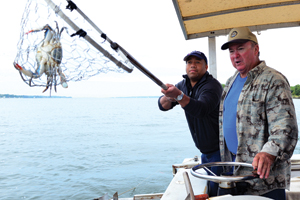
Trot lining for crabs; department photo
Learning a new trade
Vlahovich and CHA provided a five-day training course to interested watermen. Three days were spent in a classroom teaching the ins and outs of running a business, with aspects like marketing and customer service. Guest speakers and businesses were also brought in to help.
“Five days won’t make a waterman a heritage tour guide, but it planted the seeds,” he says.
On the fourth day, watermen were put on the water for trial runs of their tours. They had to determine costs, equipment, stories and everything else that goes into the tour. On the final day, watermen had to find guests and take them out on a tour.
“I think the main thing was teaching them the thematic tour element,” says Vlahovich. “They have a story to tell. Get them to realize the importance of telling that story to the public.”
Now, watermen are leading a variety of tours, including crabbing expeditions, kayak trips, oyster boat dredging, historic trips down the Patuxent River and, of course, the ever-popular skipjack charters.
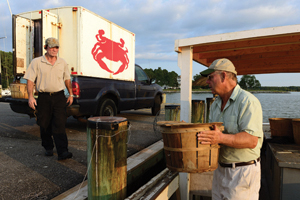
Captain Bunky Chance; department photo
Recovery and success
Vlahovich says the program was a great success, and watermen groups in other states including Louisiana and Massachusetts have reached out for advice.
Tourism—sharing the heritage with the public—is the direction the industry is moving, according to Vlahovich. Blue crab fisheries are recovering, but leading cultural tours is a great way for watermen to supplement their income.
Even if blue crab population faces another crisis, Maryland’s watermen are better prepared and trained to succeed.
“Tourism is the way this is going,” he says. “If these watermen communities are going to survive, they have to become proactive.”
As more watermen find success giving tours, more will start giving them.
“It’s a hope, a radical hope that these encounters can preserve this culture,” he says. “It’s an iconic lifestyle that speaks to the heritage of the bay.”
Article by Brad Kroner—summer communications intern.
Appears in Vol. 18, No. 4 of the Maryland Natural Resource magazine, fall 2015.


 1-888-373-7888
1-888-373-7888 233733
233733